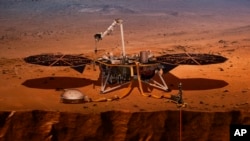The United States space agency says its Mars exploration vehicle has discovered chemical substances necessary for life.
Scientists reported that NASA’s Curiosity rover found large amounts of organic molecules in 3.5 billion-year-old rock in an area called Gale Crater. The area on Mars is believed to have once contained a large lake.
The discovery of organic molecules suggests that ancient conditions on Mars may have supported life.
Ashwin Vasavada is a scientist working on the Curiosity project at NASA’s Jet Propulsion Laboratory in Pasadena, California. He said the chances of being able to find signs of ancient life with future missions - if life was in fact present – “just went up.”
Jennifer Eigenbrode is an astrobiologist with NASA’s Goddard Space Flight Center in Maryland. She said there are three possible ways the organic material was created.
“The first one would be life, which we don’t know about. The second would be meteorites. And the last one is geological processes, meaning the rock-forming processes themselves,” she said.
NASA announced that Curiosity also discovered sharp seasonal increases in methane gas in the Martian atmosphere. This could also support the case for life. Ninety-five percent of the methane gas found in Earth’s atmosphere is produced by biological activity. Methane can come from animal and plant life, as well as the environment.
However, researchers said it is too early to know if the methane on Mars is related to life. This is because the gas - just like organic molecules – can also be formed by geological processes.
Eigenbrode believes the latest discoveries give scientists a good reason to keep looking.
“I think that we need to give the search for life on Mars due diligence,” she said. “We need to go to places that we think are the most likely places to find it.”
NASA’s latest findings were announced during a press conference last week and also released in the publication Science.
NASA head wants astronauts in orbit “in perpetuity”
Earlier this week, NASA Administrator James Bridenstine met with reporters to discuss the agency’s goals. He said there will likely be major changes related to the International Space Station (ISS) program.
President Donald Trump’s recent budget requests for 2019 have called for ending space station funding by 2025.
The U.S. government estimated it has spent more than $75 billion on building and supporting the International Space Station. After the space shuttle program ended in 2011, the U.S. has paid Russia to transport its astronauts to the space station.
The first piece of the International Space Station was launched in 1998 and was completely finished in 2011. It has been used to collect information and carry out many experiments.
Bridenstine said NASA is already in talks with private companies about possibly taking over the space station after 2025. But he added that any changes would have to be agreed to by the other 21 nations involved in the project.
But no matter what happens with the space station, the NASA chief said the U.S. remains committed to keep sending astronauts into space for many years to come.
“There are kids graduating from high school this month, that their entire lives, we’ve had an astronaut in space,” Bridenstine said. “And we want that to live on in perpetuity, forever.”
I’m Bryan Lynn.
Bryan Lynn wrote this story for VOA Learning English, based on reports from AP and NASA. Mario Ritter was the editor.
We want to hear from you. Write to us in the Comments section, and visit our Facebook page.
_____________________________________________________________
Words in This Story
rover – n. a small vehicle that can move over rough ground, often used on the surface of other planets
organic – adj. of, relating to, or created from living organisms
meteorite – n. piece of rock from outer space
due diligence – n. the detailed examination of something
graduate – v. earn a degree or diploma from a school, college, or university
perpetuity – n. forever











